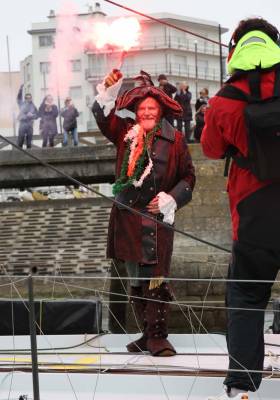Displaying items by tag: Enda O Coineen
Enda O'Coineen's Belfast Book Launch for 'Journey to the Edge'
Enda O’Coineen has many friends who sail Northern Waters. Now there’s the chance to meet up with him next week at the launch of his latest book, Journey to the Edge in No Alibis bookstore on Botanic Avenue, Belfast writes Betty Armstrong
In 2016, the 60-year-old entrepreneur and businessman Enda O’Coineen became the first-ever Irish entry to qualify for the Vendee Globe – one of the most arduous, challenging and dangerous events in sport: a solo circumnavigation.
Having made it more than halfway, through some of the most perilous and unpredictable conditions imaginable, hundreds of miles off the south coast of New Zealand, Enda’s mast was ripped off in a mini-hurricane and it looked like his race was over.
However, his first instinct was not to give up, but to try again… and late in 2017, through sheer grit, determination and incredible human resilience, he sailed the Kilcullen Voyager into the history books.
The Galway-born businessman will be in Belfast on Tuesday 3 December for the book launch 18.30hrs. He will also be supporting the Atlantic Youth Trust in Belfast whose mission is to bring young people from Northern Ireland and the Republic of Ireland together for youth development voyages on a purpose-built tall ship. You are invited to attend. No Alibis is at 83 Botanic Avenue, just a couple of hundred metres out of town from the Railway Station at Botanic.
Enda O'Coineen's book Journey to the Edge is available here
“Inspirational” is the word that has leapt out of every set of reports and comments about Enda O’Coineen’s achievement in getting the IMOCA 60 Souffle du Nord/Team Ireland to Les Sables-d’Olonne on Sunday.
Although his lone voyage from New Zealand to France may have started on January 27th and finished on April 1st, it was during the final stages in March that he overcame the Atlantic at its most challenging to bring his ship home to a port which truly appreciates his courage and tenacity, making him a very worthy “Sailor of the Month”.
Lone sailor Enda O Coineen will soon – barring any cruel last-minute setbacks - complete his current personal Odyssey to finish his very individualistic version of the Vendee Globe Round the World course writes W M Nixon. He’s slightly ahead of schedule, and has had to slow back for arrival off the Vendee Globe start-and-finish port of Les Sables d’Olonne in the Bay of Biscay at the planned time tomorrow for a rapturous official welcome on Easter Sunday, the Feast of the Resurrection.
As with many things to do with the gallant 61-year-old Galwegian, the world and its events as seen by Enda are sometimes in a very different framework, or at the very least a fresh perspective, by comparison with the perceptions of the rest of us. But with sheer force of personality, endless determination, and the influence exerted by the moral strength of his matchless personal courage, even if he doesn’t actually bring us round to his way of seeing things, nevertheless we are certainly more than enthusiastic about encouraging him and his many and diverse followers to view the world as focused clearly through the Enda lens.
Thus we referred to today’s sailing towards the finish as working towards the completion of “his current personal Odyssey”. Many people would see their entire lives as just one personal Odyssey. But that is inadequate to capture the essence of the way Enda O Coineen lives. With Enda, it’s always a case of: “What is he doing now?” and then: “What on earth will he do next?”
 The effects of seafaring. Enda O Coineen in buoyant and well-fed shape when the going is good (above), and showing the strain (below) as big problems need to be solve
The effects of seafaring. Enda O Coineen in buoyant and well-fed shape when the going is good (above), and showing the strain (below) as big problems need to be solve
He’ll pack more into two or three years than the rest of us will fit into several lifetimes. And the challenge of continuing his dismasted Vendee Globe campaign from New Zealand on round Cape Horn and back to the finish has definitely been an Odyssey in itself.
As it was, there was another typically Enda story developing even before the Vendee Globe Race started on November 6th 2016. The media alighted on this newsworthy Irish character setting his own agenda in the Race Village in Les Sables. His IMOCA 60 Kilcullen Voyager, already something of a veteran, made for an attractive alternative to the frighteningly high-powered state-of-the-art hot favourites. Those machines, with their latest foils and other gizmos being hinted at by smooth-talking official communicators, seemed a world away from the doggedly determined yet ready-to-talk Irishman.
Then with the race itself well on the way, and the fleet finally sailing in pleasant conditions, Enda surprised everyone again. While the rest of the skippers were tweaking and tuning for flat-out racing, he took time out to give us a poetry reading. It was Joseph Mary Plunkett’s “A Wave of the Sea”, and he read it very well. It was a moment of extraordinary human communication. And it quietly but strongly reminded us that while we ashore in comfort may tune in and out of following events like the Vendee Globe as and when we please, those actually racing are doing it through demanding days and long weary nights, week in, week out - whatever the weather.
So we noted that in December beyond the Cape of Good Hope, Kilcullen Voyager seemed to be finding the groove with greater frequency. On one day of days, Enda recorded the best 24-hour run of the entire fleet. Admittedly the fleet was extremely spread out by this stage, yet that top day’s run was a matter of deserved jubilation at home, and he became the Afloat.ie “Sailor of the Month (Offshore)” for December 2016.
But on the 1st January 2017, things went pear-shaped. In gusty weather southeast of New Zealand, a sudden squall over-powered his autohelm, and Kilcullen Voyager was spun into a gybe which left her dismasted. The race was over. Or was it? The doughty skipper tidied the tangle of broken spars and rigging as best he could, and started crawling towards Dunedin 180 miles away. And by the time he got there, he was determined that somehow or other, he would sail the rest of the course back to Les Sables d’Olonne.
And here he is this morning, into the Bay of Biscay, on course for his finish. All Ireland is with him. President Higgins even called him on Satphone a while back to congratulate him when he crossed the equator to notch a circumnavigation. As a story, it’s just pure gold.
And it remains both gold and pure, despite the fact that he’s sailing an entirely different boat from the one he started in. For the world of the Imoca 60s is not the small-scale sailing world in which most of the rest of us operate. On the contrary, it’s the world of people like Marcus Hutchinson who reputedly has access to a warehouse full of IMOCA 60s in Brittany, and in addition to dealing with the enormous challenges he faces in managing top-flight French Vendee Globe campaigns, he gives generously of his time to helping anyone from home in Ireland.
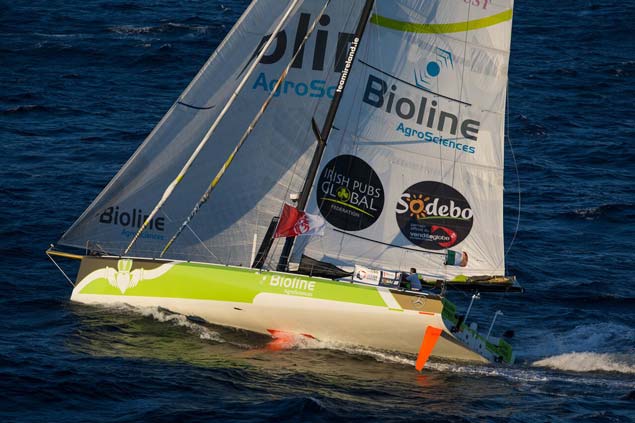 The boat he started with – Kilcullen Voyager in the Bay of Biscay
The boat he started with – Kilcullen Voyager in the Bay of Biscay
 The boat he is completing the course with – Souffle du Nord Team Ireland
The boat he is completing the course with – Souffle du Nord Team Ireland
For although he is a top behind-the-scenes operator in France, he started his sailing in Ireland. In Howth, to be precise, where he and his friend and contemporary Gordon Maguire had sailing discipline put on them under the formidable tutelage of instructor Gillian Guinness. When Gillian Guinness teaches something to do with boats and sailing, it stays taught, and the subsequent stellar careers of Gordon Maguire and Marcus Hutchinson tells us all we need to know.
But back in January 2017, the Enda O Coineen’s Vendee Globe challenge seemed to have hit a brick wall. Yet thanks to some lateral thinking and the advice and assistance of Marcus Hutchinson, they were to find a solution which is so off the wall that its very craziness is now an integral part of the big story.
Kilcullen Voyager was not the only Vendee Globe participant to stagger into New Zealand in a damaged state. Others ended up there too, either directly or else from Pacific islands in order to be shipped back to Europe. But one which stayed on for the time being in New Zealand was Souffle du Nord, group-owned by 180 investors who were business owners from Nord, the most northerly region of France.
This is a territory seen as impossibly remote border country from the deep heart of La France Profonde. It’s perceived as a peripheral place despite its handsome capital town of Lille, so 180 business in Nord were keen to promote its qualities on the bigger stage. Sadly for their hopes, while she was going well Souffle du Nord had suffered severe hull damage after hitting an unidentified floating object, which meant the race really was over for her 35-year-old skipper Thomas Ruyant.
But thanks to Enda O Coineen’s work with Atlantic Youth Trust, the Irish support team have close relationships with key people in New Zealand. This camaraderie has resulted from CEO Neil O’Hagan forging friendships with the Spirit of Adventure Trust and their 40 metre school-and-training barquentine Spirit of New Zealand, the special links being with the Chairman Steve Fisher and the CEO Dean Lawrence.
This meant that the Irish group were given generous access to a base in Auckland, which resulted in the entire tale taking this bizarre new turn. It emerged that the best business plan was for the mastless Kilcullen Voyager to be shipped back to Europe where Marcus Hutchinson had a buyer, while the Kilcullen organisation took over Souffle Nord to get her fixed up in New Zealand, following which Enda could sail her back to France to complete his circuit.
 The deal is done. Enda O Coineen and Thomas Ruyant bring their flags together in the town square in Lille
The deal is done. Enda O Coineen and Thomas Ruyant bring their flags together in the town square in Lille
The bottom line for the agreement was that Souffle du Nord/Team Ireland’s mainsail logo would continue to promote the legend of the symbolic humming bird over any commercial interest, the story being that with the outbreak of a large forest fire, the mythical little humming bird kept flying to the water and then dropping it on the fire, the message being that if everyone does a little, a lot can be achieved.
The deal was agreed at a meeting in the Nord capital of Lille with Francois Bouy, the President of the boat’s 180 supporters, and Sylvain Derreaumax the Project Manager, with a handover of ensigns between the two skippers in the town square, and then out in New Zealand work could continue on the hull repairs.
It was a major job undertaken ashore and afloat, but with Stuart MacLachlan as Project Manager and every sort of hospitality support from ex-Pats like Rodney Walshe and Billy Walshe, all was possible. Nevertheless the level of hands-on work required was formidable, and Maxim Bouy and Pierre Tesson, two young recently-qualified French naval architects who went out to work on the project, became so absorbed in the task that they lived on board during the final three months in Auckland.
 November 2017, and Souffle du Nord Team Ireland’s hull repairs have been completed, but much more needs to be done before she’s ready for sea.
November 2017, and Souffle du Nord Team Ireland’s hull repairs have been completed, but much more needs to be done before she’s ready for sea.
Departure was pencilled in for the end of January, hoping that it wouldn’t mean arriving at Cape Horn so late in the season that the the worst storm period would already be on the region, yet also allowing for the hope that the North Atlantic would have settled down a bit after the worst of the winter storms by the time Enda and his new mount crossed the Equator.
The final stages of getting the boat back in full commission were hectic, with Nin O’Leary and Joan Mulloy arriving to back up Enda and the team already there in the last big push, while Alex Thomson of Hugo Boss was generous with his input on routing, for the Southern Ocean was in a restless mood.
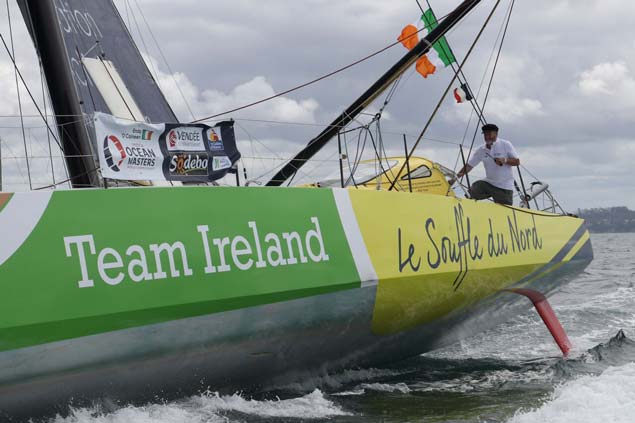 Getting used to the new boat – each IMOCA 60 is an advanced learning course in itself.
Getting used to the new boat – each IMOCA 60 is an advanced learning course in itself.
It certainly didn’t wait around to show its damaging side to Enda as he sailed into the voyage back to Europe after completing a circuit of New Zealand, as he soon found himself grappling with broken battens and many of the other travails which lurk ready to pounce on an IMOCA 60. Yet with clever tracking he managed to avoid the worst of the storms, and every day was that much nearer Cape Horn.
It was February 17th when he rounded, with a howling nor’wester hitting 49 knots most of the time to the west of the Horn, but things quickly eased once he got into the lee of Tierra del Fuego. “Into the lee of Tierra del Fuego….” – the deeper meaning of that little statement emphasises the continuing drama of Cape Horn, but it meant that folk at home tended to think that the job was almost done and dusted.
Yet it is only now, 64 long lonely days and more than 14,000 miles since leaving New Zealand, that the gallant little humming bird is back within striking distance of the finish. They could, if allowed, be finished today. But the constraints of share life are already returning, and Marcus Hutchinson is orchestrating a proper return with the Mayor of Les Sables d’Olonnnes formally welcoming Enda O Coineen on Easter Sunday, with it all having to be fitted around the fact that this key port in the big time ocean racing scene is slightly tidal, with a four hour window when an IMOCA 60 can enter un-hindered.
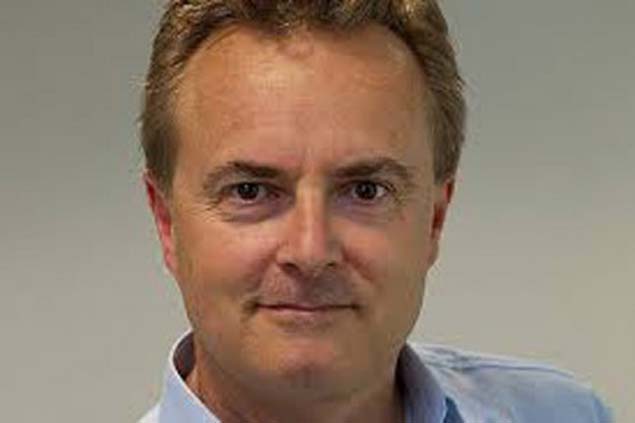 Marcus Hutchinson is calling the shots on Enda’s return to Les Sables-d’Olonne
Marcus Hutchinson is calling the shots on Enda’s return to Les Sables-d’Olonne
So Enda and the little humming bird have been obliged to mosey around for a while in disagreeable conditions in the southern Bay of Biscay in order to keep to a programme which fits the busy Mayoral diary and the height of the tide at les Sables d’Olonnes. A long way indeed from Cape Horn, and the joy of reaching the lee of Tierra del Fuego. But once the formalities are over, Les Sables has a pub called Le Galway, and in recent days it has been organizing Guinnness on tap. It could only happen with Enda.
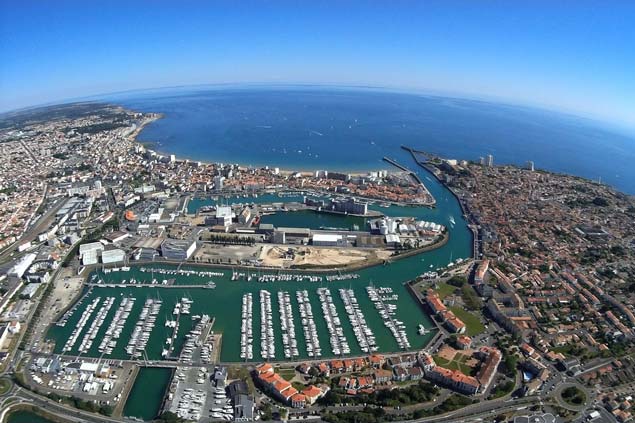 Les Sables-d’Olonne. It’s a fine big harbour once you’re in, but that’s a narrow enough entrance to be headed for when you’ve had 65 days of wide open spaces.
Les Sables-d’Olonne. It’s a fine big harbour once you’re in, but that’s a narrow enough entrance to be headed for when you’ve had 65 days of wide open spaces.
Ireland 'Can Benefit from Nurturing Sailing'
Two recent letters in The Irish Times serve as a "reminder of the high value of sailing to the social and economic health of Ireland".
Enda O Coineen - who helped bring the Volvo Ocean Race to Ireland - writes on Saturday last of the "shame" of becoming "quayside bystanders" that many felt welcoming the Norwegian tall ship Statsraad Lehmkuhl to Dublin when Ireland's youth ocean sail training scheme is being ended due to a 100% budget cut.
Echoing his sentiments, Peter Vine asks: "Is it not time to acknowledge that this maritime nation can benefit enormously by nurturing sailing and a love of the sea among our young people?"
Vine argues that efforts towards a "new viable Tallship for Ireland deserve individual, corporate and Government support". Do you agree? Have your say in the comments below.



























